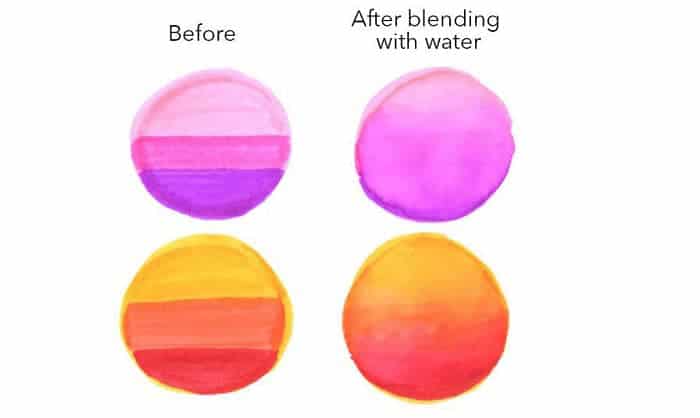Are you not satisfied with the result of your colored artwork? Does it seem too bland or unrealistic? Then, you might be lacking the proper way of blending color. In this article, you will learn how to blend markers the easy way.
Knowing the tricks will help you obtain beautiful results that will make your artwork come to life. All you have to do is to get some markers and your uncolored art on paper. Start coloring your work in different shades and intensities that will create a blended look.
To know more about the process, read further below.
Table of Contents
Prepare Everything
Successful blending transforms an ordinary artwork into something extraordinary, and to get that, the proper things are required. So, before we go through the whole process, I recommend you get the following:
Markers
Choose a marker that you are comfortable working with. Alcohol-based pens are typically ideal. In fact, they are considered as the king in the art world because they blend smoothly, just like the Copic Marker 72-Piece Sketch Set.
Alcohol-based pens are also famous for their excellent versatility and quick-drying ability. This allows them to offer smoother blending, making these markers superior.
You can get two or three colors in different shades or a single-color marker you can use to blend effectively.
Your uncolored artwork
Step-by-Step Guide to Blend Markers
Now that you’ve got everything on hand, it’s time to know the basics of coloring.
Step 1: Work on One Part or Section at a Time
Focusing on one particular section allows you to work on all areas slowly but surely. It also gives a more detailed result and excellent blending that makes your work come to life.
If you are using one color in the same pen, you only have to consider the saturation levels that will appear on your paper. This, in turn, also affects the shade of the artwork.
Alcohol-based pens require you to blend fast from one pen to another. Remember that the result would be poor and full of streaks if your first pass dries out before the next shade or color comes into action.
Suspended particles of the ink move freely and mix together. If the color sets on our artwork, there will only be a tiny chance of motion that results in poor blends.
Step 2: Color with Light Colors First
If you opt for a single color with different saturations, you can begin by applying a single layer of tone to your work. Re-apply the same ink while avoiding the area that will be having the lightest shade.
The simple trick to this is re-application. You have to shade again the areas that you want to be the darkest. Using a single pen when coloring might be easy because the light and saturation level of the marker do not vary.
This trick gives you smoother transition levels between different shades. However, it shows a monochromatic result, and the variety of the transition levels is limited. The good thing is you can do this on any paper.
However, if you can work around colors very well, you can get two to three shades of similar color ranges. So, get the lightest shade of your chosen color. And when you lay down colors, it is best to go from the brightest to the darkest ones.
If you opt for different shades of warm colors like yellow, summer melon, and sunset orange, use yellow first.
If you’re using water-based markers, to deliver a smoother tone transition and saturation, you can also dip your marker’s tip in water. It will give a look like this:
Step 3: Color with the Dark Tone Next
The next thing to do is get the second color that’s way darker than the first but not the darkest on the list. In our example, this color would be the summer melon.
Overlay and blend it over the color yellow. But ensure to leave some tints of the original yellow color. Otherwise, the blending will be useless.
You can resume working with the yellow color after laying down the second color. In this way, you can soften the part where the two shades come together.
Even though you don’t intend to create new colors out of the ones you used, there are chances that they will form. And it’s one amazing aspect of blending because you can save money from not buying the exact color that was created.
You will start to notice beautiful results as you keep on blending. One color easily and seamlessly flows to the next color.
Step 4: Proceed with the Darkest Color on the List
If you have more than two color shades, this is the best time to overlay the darkest color into your artwork. It will give the best transition to make your work less flat and more captivating.
After you applied all color shades onto your paper, you can then blend over lighter colors with the diluted darker ones, and vice versa.
Step 5: Repeat the Previous Steps and Keep Blending
Do the previous steps again until you are happy with the results.
Step 6: Add Highlights
The final process is adding in some whites. The white color is an excellent tool to add highlights to your artwork.
Proper shading and shadows are critical components of making your artwork and illustrations look as realistic as possible.
However, perhaps the most vital technique that makes any piece of art stand out is how seamless the blending is.
Step 7: Expanding on Large Areas
After working on a specific area, it’s time to hop on another section and start working on large areas. However, blending colors over large areas is a bit challenging, especially for beginners.
The step is pretty much similar to smaller ones, though. Work while the ink is wet to give smoother colors that blend beautifully when they overlap. Keep lots of marker ink flowing on your paper.
The important thing is how you handle the transitions between your chosen colors, which must be treated with constant overlaps using the same pens.
Pro Tips:
- Ensure that the color is still wet when blending. This will give you smoother transitions that will give the best result.
- You have to work in a back and forth direction between the colors when you start blending to ensure a smoother color transition.
- Do note that using more colors or shades results in a better output.
- I recommend coloring quickly, allowing you to work with wet ink for smoother blends.
If you are interested in making your blends smoother and more realistic, you can check out this video. You will know what ideal papers to use and more blending techniques through this 16-minute video. That’s why it’s really worth checking out.
Conclusion
That’s it! Did you enjoy this tutorial on blending markers? Do you want to read more other blending tricks using Prismacolor markers, Crayola markers and Ohuhu markers?
Now you can create beautiful and smooth transitions on any color, making your artwork come to life. Knowing the pro tips on how to blend markers also helped me avoid streaking, which gave me a handful of compliments from my clients, friends, and family.
Always remember to use alcohol-based markers like the Copic Marker 72-Piece Sketch Set, because they are famous for giving smoother blends.
We would love to hear from you, too. Tell us about your experience in the comments and share this article with your artistic friends to make their work colorful and alive.

I am a former art teacher, so it is evident to me the importance of art in educating the new generation. We also want to help parents who plan to teach their children and desire the best tools and tips for them.

